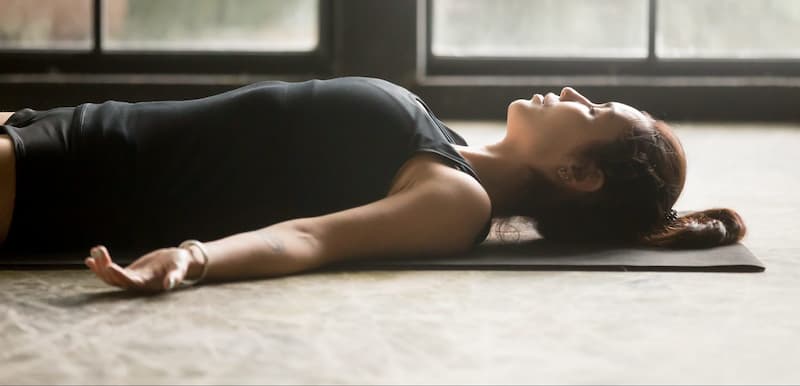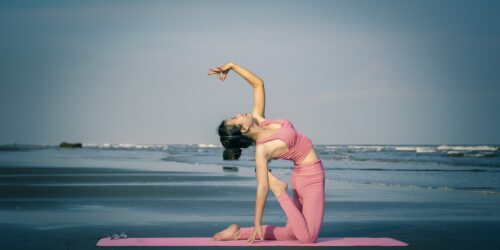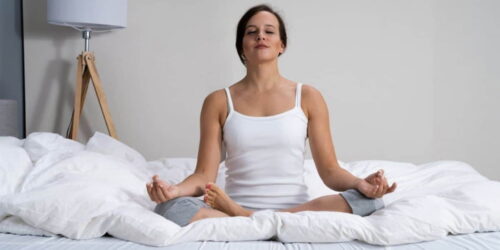Can You Meditate Lying Down? Certainly Yes! How To Lying Down?
To start with, can you meditate lying down? YES!
Such newcomers might soon experience physical challenges in maintaining the lotus position while remaining focused. Some individuals may even be born with physical conditions. The posture you can use for your practice, however, is just one of many. People who are experiencing certain pains or turbulent minds should definitely try more relaxing meditation positions like lying down or reclining in a chair.
Simply put, not everyone is in the best shape all of the time with an upright posture. The alignment of the spine and comfort are crucial during meditation.
Learn about the different types of meditation that are most effective when done while lying down in this article.
Table of Contents
Can You Meditate Lying Down?
The answer to this frequently asked question is that, strictly speaking, there are only four positions in which to meditate: standing, sitting, lying and walking. However, it is not quite that simple, and the following reasons are why:
The best position is seated. It offers the capacity for, if not the ideal equilibrium of concentration and relaxation. Additionally, using a chair is acceptable. Both the body and the mind are more likely to be awake and focused when the body is upright. When we are seated, there is also a certain amount of letting go and relaxation that occurs. Compare this to standing, where most people feel a little bit too tense after just a few minutes of remaining motionless, or lying down, where most people immediately feel a little bit too relaxed and fall asleep. Walking is a completely different experience.
Therefore, sitting is generally always preferred to lying. Only when we are too uncomfortable or in pain to sit down is there an exception. Naturally, lying flat on the ground is a perfectly acceptable alternative in these circumstances. If you choose to do this, I’d advise putting a thin pillow under your head and bending your knees to 90 degrees so that your feet are flat on the ground. By doing so, you’ll safeguard your lower back without putting it under additional stress.
Ways To Meditate Lying Down Or In Bed
“The best way to determine which meditation position is right for you, according to Los Angeles-based meditation coach and teacher Josephine Atluri, is to choose one that is comfortable for you.
“Prioritize that emotion because you want to be able to maintain your practice over time, not just for that particular meditation. You want to be able to return to it because it’s a good experience for you.”
(Check out these 5 suggestions for making meditation a daily habit.)
The following steps should be taken to assume the correct position on the bed or mat:
Use Props If You Want
“Have pillows under your knees to support your spine and elevate your feet, particularly if you have trouble staying awake, advises Atluri. “You can also place a pillow under your neck to support proper alignment.”
She also advises wearing a weighted blanket to help you relax if you’re restless, as well as an eye mask if you have trouble closing your eyes.
Souza suggests folding a blanket lengthwise and using it as a bolster to support your spine from tailbone to crown if you’re on a mat. She adds that this can also help you breathe more deeply.
Open Chest
“Atluri advises rolling your shoulders back and moving them away from your ears.
“Your chest sort of pops up a little bit when you do that, almost as if you were pressing your shoulders and back into the ground, and that’s great for relieving stress and anxiety.”
Support Spine
“According to Souza, it’s nice to have the spine fully extended, so you should have support from your tailbone all the way up to your head.
“Furthermore, you need room on either side of your spine so that your arms can rest comfortably.”
Let Legs Fall Where They May
Make a natural descent with your feet and legs.
Souza asserts that there are some additional options.
“You can either have your knees bent or have your legs fully extended, as in corpse position, according to Souza. “The butterfly pose with my knees open like a book and my feet together is a pose I really enjoy occasionally. There are different leg shapes, but you really want a long spine.”
Relax Into The Position
“As you move up from your feet to the top of your head, make a mental checklist to determine where you might be holding onto tension, suggests Atluri.
The objective, she continues, is to practice in the most receptive and open manner possible.
Other meditation advice includes letting go of tension in your hands, jaw, and belly; these areas may be tight unknowingly. You can also try lying down while meditating.
“Because they are so used to holding their phones and typing, people frequently have their hands clenched tightly, according to Atluri.
“She continues, “Soften your forehead and the corners of your eyes because we squint constantly from looking at screens. See more about How To Solve Your Problems Through Meditation?

The Best Meditate Lying Down Position
The best meditations to practice while lying down or in bed are listed below. Some free meditation apps also offer guided meditation for right before bed. To determine which types of meditation most interest you, think about reading about the various meditation practices.
Body Scan
“My favorite one is the body scan, where you break down the body inch by inch and really just tune in to the various sensations and qualities to the different parts of the body, says Dora Kamau, a Vancouver, Canada-based mindfulness and meditation teacher for Headspace.
“Making an inventory of what is present and what feels good, tense, or tight, start at the top of your head and work your way down to the soles of your feet.”
You can scan while sitting, of course. According to Atluri, the advantage of lying down is that you can work through every body part at once because everything is essentially even.
“So it’s not like you’re sitting down and exerting a lot of pressure on your seat before you lose feeling in other parts of your body, she adds.
Mindful Breathing
Always begin a practice by breathing deliberately, especially before lying down to meditate.
“According to Kamau, lying down with my hand on my stomach helps me really focus on the sensation of my chest and stomach rising and falling as I breathe in and out. “As a result, you’re able to focus because you’re not distracted by a hip or backache.”
According to Kamau, mindfulness of the breath causes you to stop concentrating on your racing thoughts, which lowers stress and anxiety.
Souza advises that you should just label your breath to make this practice even simpler. “Every time you inhale, you quickly label it as “inhaling” or “breathing in,” and every time you exhale, you do the same thing: “exhaling” or “breathing out,” she says.
Just focus on your breath and say, “Oh, I’m inhaling,” as your thoughts stray (it happens during the process).”
Diaphragmatic Breathing
Normally performed in an inclined savasana or semi-supine position, diaphragmatic breathing is a calming pranayama technique. The technique instructs practitioners to breathe through their nose while placing one hand on their chest and the other on their belly. When breathing, belly expansion and contraction are more prominent than chest movement.
The body’s most effective breathing muscle, the diaphragm, is strengthened by deliberately breathing in this way. As time passes, breathing becomes easier, oxygen exchange is more effective, and the heart rate decreases.
Focus On An Affirmation
You don’t just have to pay attention to your breath. You can select an affirmation or a mantra (a word or sound).
The first thing you should do in the morning, according to Souza, is to concentrate on a positive aspect of your day.
I’m safe, I’m loved, I’m at peace, and I’m strong and confident are a few affirmations you can say as you inhale and exhale, she suggests.
“While you’re in a state of meditation, using positive affirmations can help you stay mindful of your inner goodness, your support network, and your strengths. You might have to test out a few to find the one that resonates with you and functions for you, and that could also change and evolve over time, she adds.
The better, in general, is to have more tools.
Yoga Nidra
Yoga Nidra, also referred to as yogic sleep, is a type of meditation for which a supine position may be ideal. The practitioner enters a potent transitional state of consciousness between the awake and sleeping states during this guided practice. As awareness moves inward, senses turn away from the external environment.
According to research, trauma survivors can benefit from yoga nidra. The parasympathetic nervous system’s activity can be changed by a regular practice, which also lowers heart rate variability. See more about Can You Do Yoga If You’re Not Flexible?
Sound Healing
A listener is invited to relax in the most comfortable position while experiencing the vibrations of singing bowls, gongs, or windchimes during a sound healing session. When in a supine meditation position like savasana, the body can rest and absorb this calming energy.
Sound therapy can lower inflammation and boost immune function by lowering stress, thereby defending users against stress-related chronic disease.
Sleep Meditation
Lack of sleep causes inflammation, weakened immunity, and a variety of physical and mental illnesses, much like stress does. It is frequently up to our exhausted selves to make an effort to stay awake and alert while meditating. Sleeping through the night is the aim of sleep meditation. Consciousness is brought into a dream state by guided meditations or calming music.
For those who want to fall asleep on purpose, lying down is the ideal position for meditation. Try lying down and keeping your eyes open if that’s not your goal.
Try different things to see what works best for you. The Buddha also said in the Kalama Sutta, “We should not go by reports, legends, or traditions,” and “When you know for yourself that ‘these qualities are skillful,’ you should enter and remain in them.”” The most skillful thing you can do occasionally is to lie down and meditate.
Lying Down Meditation Benefits
The many advantages of meditating while comfortably sprawled out on the floor go far beyond just being a good place to start for beginners. For those with a particularly stressful lifestyle or certain psychological conditions like ADHD, anxiety disorder, or depression, this technique is known to be the best option.
This results from the fact that this is the most relaxing meditation position, when your mind tends to slip into this cozy and secure state, similar to the one just before sleep. This state is undoubtedly not for everyone because for some people it can be just too tranquil.
To elaborate, lying-down meditation is a fantastic treatment for sleep disorders. Similar to warming up your muscles before a workout, allow yourself to meditate for 10 minutes before attempting to fall asleep. To fall asleep, it usually helps to unwind and bring your focus back to your mantra, your body sensations, or, even better, some nice deep breathing.
You get the highly rejuvenating quality of rest that you deserve when you have complete control over this shift to sleep. To bring your mind from sleep to wakefulness, you might also want to try meditating while lying down. Even a few minutes will give you a boost of good vibes that will enable you to greet the day with a smile.
Last but not least, if you experience chronic pain in your back, legs, shoulders, or any other area of your body, this type of practice may be your best, if not your only, option. If the discomfort is restricted to sitting meditation, you might want to try breathing into the painful areas or slightly changing your position to deal with the discomfort. However, if that pain follows you outside of your session times, it might be too distracting and ultimately more harmful.
The End
All of the vertebrae in your back should be in contact with the floor as you try to maintain a nice straight line. If you find that uncomfortable, you can also squat with your feet flat on the ground while bending your knees. For better support and to keep your back straight, it’s also a good idea to have something like a thin cushion nearby.
It’s preferable to keep your eyes fully or slightly open while meditating on your back because you are much more likely to nod off at that position. You can fix your attention on a barren area of your ceiling or a decoration that is suspended in the air above you. Naturally, closing your eyes while sleeping is not a problem if you meditate first.
Thank you for reading, and good luck.





